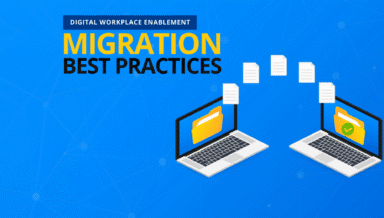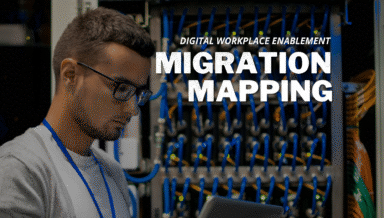Top Concerns with Hybrid SharePoint: Migration

Editor’s note: This post is one in a series from CollabTalk CEO Christian Buckley called “Top Concerns with Hybrid SharePoint.” Read the other blogs in the series below:
- Administration Complexity
- Moving Customizations
- Connecting to Legacy Data
- Demonstrating Value
- Organizational Distruption
- Customizations and Branding
My initial foray into the world of SharePoint involved a migration. While it was a small volume of content, the information was business-critical, and the customer wanted to understand the entire process, what would be moved and how, and wanted to see the new environment and approve it before giving the thumbs up to the move. That was back in 2005, when SharePoint was considerably less complex than it is today.
Migration continues to be a major concern for organizations – whether upgrading from an older version of the platform to the latest release while switching out some hardware components, or re-thinking their entire deployment, including a move to a hybrid deployment. For some organizations, hybrid is part of a long-term transition plan to the cloud, while for others hybrid IS the plan.
SharePoint has matured as a platform, and it continues to grow and evolve as both an on-premises collaboration platform and a critical component of Office 365. The benefit for your company is that there are now many different paths toward the cloud, and more flexible architectural options that enable you to better keep up with your constantly changing internal and external collaboration needs.
Why consider hybrid over a straight migration to the cloud? There are a number of reasons why a company might delay, or even rule out a move to the cloud:
- Key features may be missing, due to third-party solutions or customizations that have become business-critical.
- There may be concerns over the time and cost of re-architecting some aspects of your environment.
- Due to geographically-dispersed teams, high-availability scenarios, or performance concerns, moving to multi-tenant cloud solutions may risk certain Service Level Agreements (SLAs).
- Concern around dependence on third-party vendors to manage servers.
Microsoft is working hard to help companies move past these concerns – but the fact remains that for those companies who have spent years building out SharePoint, few are able to go entirely into the cloud without a major migration – and possibly re-design.
Hybrid environments give many organizations the flexibility they need to move away from the all-in migration to an incremental model.
Quick Overview
In this video, I met with my former peer, Bill Baer (@williambaer), a Senior Technical Product Manager on the SharePoint team, and someone who has been involved with SharePoint migrations since the very start of the platform. Bill shares some great insights into the complexities of migrations, and some of the things you should consider as you start your planning.
Why is this topic important?
Migration has never been point-and-click. For the majority of organizations considering a hybrid strategy, migration will be central to your plans. As an organization, you need to consider the content to be moved, configurations and applications to be rebuilt or refactored, the structure of your content classification and taxonomy, and the governance and administration policies and procedures to be realigned for hybrid – with some aspects being managed as centralized activities, and others managed on one or the other environments (on-prem or cloud infrastructure).
There is much to be considered before a single list or library is moved. My guidance has always been to begin with an environmental analysis, giving you a clear picture of what you have in place in today so that you better understand what needs to be moved. Document your permissions, information architecture, templates, content types, taxonomy — and understand (and validate) the ownership of each area.
Governance should always be a priority in your migration planning. Define what policies, procedures, and metrics are used to manage your environment today, and then consider how these things will work within your hybrid environment – and be prepared for the gaps.
Microsoft Guidance
Almost every Microsoft whitepaper or blog post on the topic of SharePoint migration begins with the recommendation to perform some kind of analysis on your existing SharePoint environment. You need to have a clear picture of the content and structure you plan to move, of course. However, migrations are also an opportunity for operational assessment and optimization. In other words, use your migration as a chance to clean up and improve on your system, regardless of its on-prem, cloud, or hybrid destination.
There are a number of migration articles and resources available on TechNet and through the FastTrack program, but Microsoft recognizes the complexity of SharePoint migrations – and recommends that customers take a look at the partner ecosystem for more robust migration solutions.
Microsoft also highly-recommends running several migratin tests before moving forward, allowing you to better estimate the time and effort of your move, and to validate your tools and methodologies.
How AvePoint can help
As one of the leading (and largest) SharePoint ISVs in the ecosystem, AvePoint provides a number of tools to help customers migrate, manage, and secure their hybrid SharePoint environment. DocAve Migrators for SharePoint support all stages of your migration projects – providing the highly-recommended pre-migration assessment and planning tools, as well as the capabilities to do all of your heavy lifting, with minimal business disruption.
AvePoint can help in four primary areas, depending on your migration strategy:
- SharePoint Migration Planning and Execution
- Direct Migration to SharePoint
- High-Speed Migration to Office 365
- Data Integrity Preservation
My recommendation is that you begin with your pre-migration analysis, running a detailed discovery and pre-scan to help you create an inventory of your legacy environment, from which you can plan and prioritize your migration, as well as reorganize your information architecture.
Additional Resources
While you can always search the internet for guidance on migration, AvePoint have been in this space since the beginning of this SharePoint journey – and their website is a treasure trove of planning tools and best practices. Here are a few of these resources to help your migration planning efforts:
- SharePoint 2016 Features: What’s Sticking in the Market [Blog]
- 3 Ways to Eliminate Pains in Your SharePoint 2016 Migration Project Planning [Blog]
- Why Hybrid? [Blog]
- 5 Reasons You’ll Love SharePoint 2016 Hybrid [Blog]
- Spring Cleaning Your Data for Modernization [Blog]
- Exploring Your Microsoft SharePoint Environment Before Migration with the Discovery Tool [Blog]
- SharePoint Migration Discovery and Analysis with AvePoint Discovery Tool [Video]
- AvePoint Discovery Tool for SharePoint Pre-Migration Discovery Analysis [Product Overview]
- Hybrid SharePoint Study [Whitepaper]
I hope you find this information helpful as you build your hybrid SharePoint plans. Look for more guidance in this series on hybrid SharePoint, and please let me know if you have any questions – or your own best practices that you’d like to share.
An Office Apps & Services MVP and Microsoft Regional Director, Christian Buckley is an internationally recognized author and speaker and runs the community-focused CollabTalk blog, podcast, and tweetjam series.



